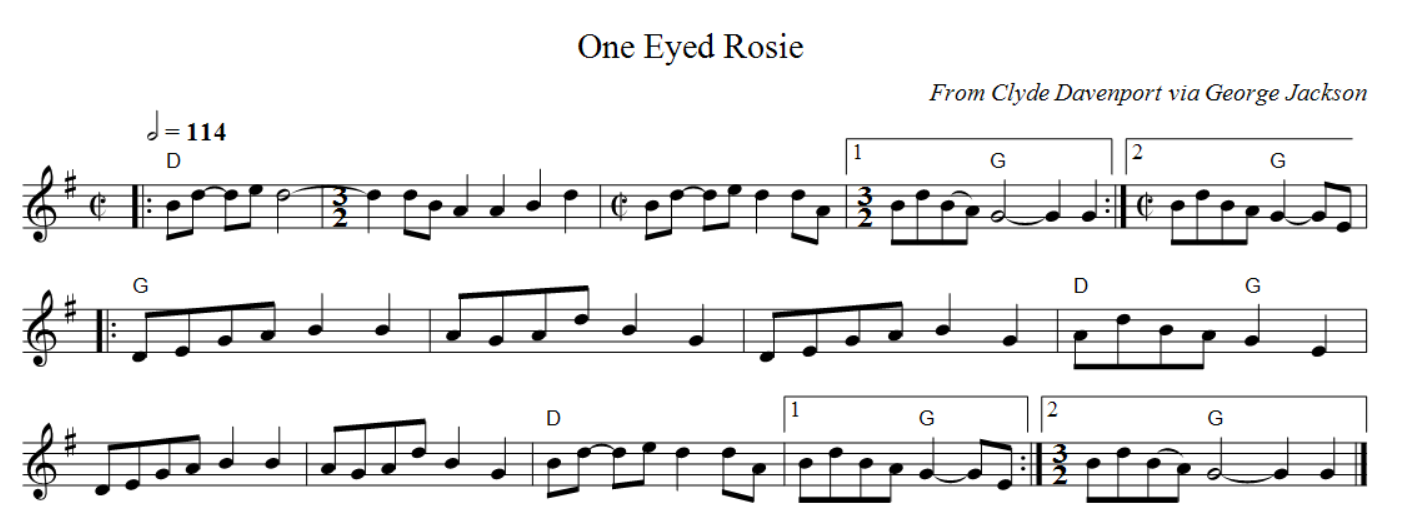This tune comes from the playing of Clyde Davenport, which you can hear at Slippery Hill.1 Clyde was born in 1921 in south-central Kentucky, where he spent most of his life except for a period after WWII when he lived and worked in Indiana. He played fiddle semi-professionally at that time, but decided not to make a career of it and stopped playing at all for nearly twenty years starting in his 30s. Jeff Todd Titon credits this break with Davenport retaining his style of fiddling, which would likely have changed had he become a professional fiddler playing bluegrass.2
In the recordings of Clyde playing this tune that I’ve heard, he is playing in a style more suitable for unaccompanied fiddle, with some notes held longer than you would expect in a “square” fiddle tune. This mimics an older style of ballad singing common in the region where the singer will “dwell” on a word or note for seemingly arbitrary amounts of time. This leads to Andrew Kuntz’s transcription of the tune at the Traditional Tune Archive3 including some measures of 5/4 and some of 3/2 in a tune nominally in 2/2.
In 2001, George Jackson and Tristan Scroggins played a version of One Eyed Rosie for Jackson’s “Fiddle Tune Friday” project, which is where I first heard it.4 In comparison to Davenport’s playing, Jackson plays the second part (which is twice as long as the first part) twice rather than once, with a “dwell” at the end of the second time through but not the first, and he holds the “dwell” note for longer than Davenport does. This results in a tune that is a different length in each repetition of each part, which isn’t something I hear a lot. When I brought this tune to the group I regularly jam with, it was difficult to play the first few times through, but then something clicked and it just made sense, despite it being one of the most crooked tunes we play together.
I later discovered that Red Dog Run (Richie Stearns, Jim Miller, Rosie Newton, and Jed Greenberg) recorded a very similar version in 20145, with the only difference being that they include the dwell both times through the second part of the tune. I don’t know whether Jackson came up with his interpretation independently or if he’d heard theirs (or someone else’s, although I don’t think many people have recorded this), but I think it’s interesting that both exist and both make sense to me, while I find it nearly impossible to play along with Davenport due to his ending phrases at spots which would make normal accompaniment have to stutter to realign.
I have no idea what “One Eyed Rosie” might refer to. In the recording on Slippery Hill, Davenport sings a line that Kuntz transcribes as “I’ll never need some one-eyed Rosie”, but I don’t hear that at all. I hear “out of the deep come one-eyed Rosie”, making me think of some cyclopean sea monster, but I doubt that’s what Davenport had in mind. In a 1985 interview,6 Davenport says that the tune was “old before the hills were for sale”, so who or what Rosie might have been is probably lost.
If you play this tune, I encourage you to try it in GDAD tuning, which makes for some nice drones in the high part.
–Josh
No sheet music files available for this piece.
- https://www.slippery-hill.com/content/one-eyed-rosie[
]
- http://web.archive.org/web/20190102225241/cds.library.brown.edu/projects/davenport/CLYDE_DAVENPORT.html[
]
- https://tunearch.org/wiki/Annotation:One_Eyed_Rosie[
]
- https://www.youtube.com/watch?v=9NkvMPmDdqk[
]
- https://www.youtube.com/watch?v=MjQ0rf_UgTQ[
]
- https://scholarworks.moreheadstate.edu/fiddlers_oral_history_project/51/[
]
